For much of the information about the owners of Claremont Buildings later Hopecote I am indebted to Jean Nisbett and her book Hopecote, A History Of A Building.
Prior to Hopecote there were three houses: 1 – 3 Claremont Buildings. Like Isabella Place, Claremont House and 113 – 117 Church Road they were built about 1805. Claremont House, 113 – 117 Church Road and 1 – 3 Claremont Buildings were all, originally 2 storeys and ‘2up 2down’.
1805
In Hopecote, A History Of A Building Jean Nisbett states that in 1805 Anne Isabella Monck, Viscountess Hawarden, ‘sold to Chas. Perks and Benjamin Wingrove a “Plot or Piece of Grounds, Messuage or Tenement… thereon erected” for which they agreed to pay £4 4s annually on 24 June’. This was on a 500 year lease.
Charles Perks (1749 – 1813) had been a pork butcher, bacon merchant and carrier and we know that in 1773 one of his horses had been robbed ‘of pork, bacon, mutton, butter a quantity of beef etc.’ Somerset Heritage Centre has “Information of Henage Ginder of Bath, pastry cook, Charles Perks of Monkton Combe, bacon merchant, John Williams, servant to Charles Perks and George Stawell of Bath, victualler, concerning the theft of two hams they believe by Samuel Danford. JP: Leonard Coward.”[1]
It appears that he bought several pieces of land on Combe Down in the Prior Park estate sales and we know he was active in land from several leases at Bath Record Office.[2]
1815
Charles Perks’ son Robert Perks (1777 – 1831) together with Benjamin Wingrove sold 1 Claremont Buildings to John Davis and 2 & 3 Claremont Buildings to William Kinson. Joseph Ponting and William Bye Lidiard are also mentioned in the deed.
William Kinson may have been the William Kinson baptised in Bath Abbey in 1741 / 1742 and in Hopecote, A History Of A Building he is said to have died in 1826. It appears he lived in 3 Claremont Buildings and rented out number 2 to a Weston Phipps from 1816 – 1823 and John Upham 1823 – 1826.
Weston Phipps may be Capt Weston Phipps R.N. (1785 – 1847) who had enrolled in the navy in 1798 and promoted post captain in 1814.
John Upham may have been the John Upham (1774 – 1834) who took over John Bull’s Circulating Library.
If it is indeed he, he was the second son of Charles Upham (1739 – 1807), who was mayor of Exeter in 1776 and whose brother was Edward Upham FSA (1776 – 1834) who was also a bookseller and a well known orientalist.
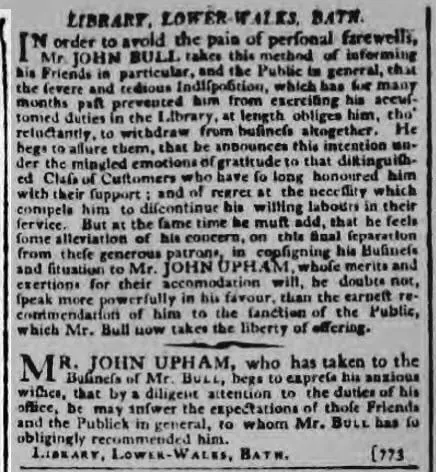
1826 – 1831 James Davis, Robert Perks, Samuel Batchellor and William Batchellor
James Davis inherited 1 Claremont Buildings from John Davis in 1826 and in 1827 rented it to Robert Perks (1801 – 1851) the son of Robert Perks (1777 – 1831) and grandson of Charles Perks (1749 – 1813).
Samuel Batchellor (1773 – 1851), a solicitor in the partnership of Batchellor, Harford & Staunton in Bath, bought 2 & 3 Claremont Buildings from the estate of William Kinson in 1828. As well as his legal practice he traded in property and in at least one benefice buying the advowson of Trotton before he died.[3]
In 1831 Rev William Batchellor (1799 – 1856), son of Rev William Batchellor (1759 – 1809), bought 1 Claremont Buildings from James Davis and Samuel Batchellor who was his uncle either sold or transferred 2 & 3 Claremont Buildings to him.
In 1831 Rev William Batchellor, who was curate of Chilcompton, married Sophia Elizabeth Newnham (1808 – 1876)[4], daughter of Rev William Moore Newnham (1755 – 1832), and brother of Rev George William Newnham (1806 – 1893) who was perpetual curate of Monkton Combe 1842 – 1863 and of Combe Down 1842 – 1877. After his marriage Rev William Batchellor transferred ownership of all three houses jointly to his wife and her brother, Rev George William Newnham.
Rev William Batchellor has a memorial plaque on the outside of the old Combe Down school building.
1840 1 – 3 Claremont Buildings for sale
1843 – 1846 Rev George William Newnham, Sophia Elizabeth Newnham and William Price
In 1843 Rev George William Newnham and his sister sold 1 Claremont Buildings to William Price.
In 1846 they sold 2 & 3 Claremont Buildings to William and Lucy Harding. He may be the William Harding mentioned in Bath Chronicle and Weekly Gazette on Thursday 3 October 1850.
After William Price died in 1863 his executors sold 1 Claremont Buildings to William Fortt (1796 – 1880).

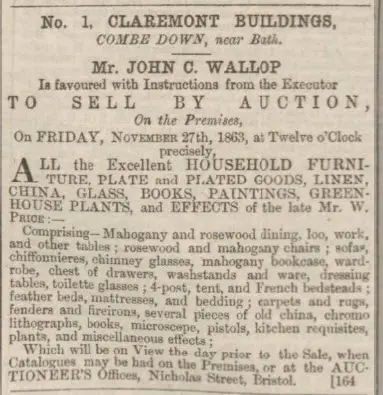
1863 William Fortt
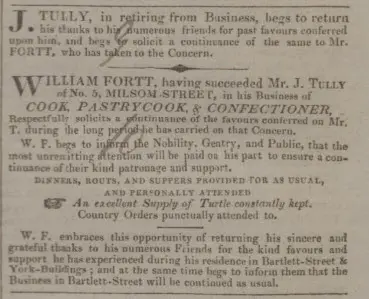
William Fortt was a ‘cook, pastrycook & confectioner’ starting with a William Fisk and trading at Gay Street and York Buildings.
He married Mary Fisk (1796 – 1846) on 6 October 1818 and had 11 children. In 1847 he married Ruth James (1798 – 1879) who was probably related to his first wife.
After he had dissolved his practice with William Fisk he took over a Mr Tully’s business at 5 Milsom Street and expanding to add 7 Bartlett Street and by 1854 he had the idea of refreshment rooms.
Soon after that in 1856 he was importing sherry[5] and by 1859 Fortt’s were also describing themselves as wine merchants[6] William Fortt retired in 1872 handing over to his son Frederick William Fortt (1820 – 1898)[7]
After William Fortt died the firm merged, in 1889, with two other Bath firms R B Cater & Co and W M Stoffel & Co to become Cater, Stoffel and Fortt Ltd raising £40,000 via preference shares which is about £18,300,000.00 today.[8]
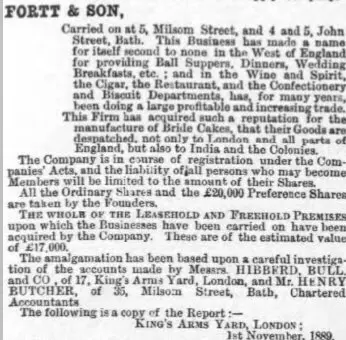
Cater, Stoffell & Fortt traded in confectionery, catering, grocery, fine wines & spirits, and the manufacture of the famous Bath Oliver biscuits.
Dr William Oliver (1695-1764), of Bath, invented a hard, dry biscuit made from flour, butter, yeast and milk; often eaten with cheese. This biscuit became known as a Bath Oliver.
When Dr. Oliver died, he bequeathed to his coachman, Mr. Atkins, the recipe for the famous Bath Oliver biscuit, together with £100 and ten sacks of the finest wheat-flour.
Mr. Atkins promptly set up his biscuit baking business and became rich.
Later the business passed to a man named Norris who sold out to a baker called Carter.
After two further changes of ownership, the Bath Oliver biscuit recipe passed to James Fortt (1831 – 1913), the fourth son of William Fortt.
1880 Rev Francis William Fowler
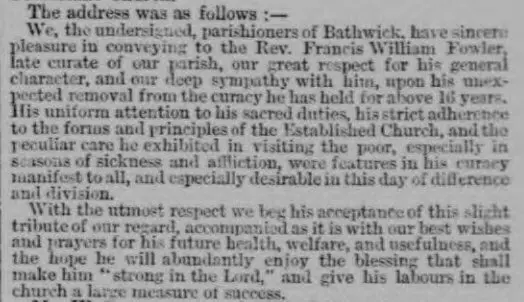
After William Fortt’s death, 3 of his 5 daughters who inherited 1 Claremont Buildings:
- Emma Elizabeth (1827 – 1882)
- Jane (1831 – 1913)
- Emily Victoria (1837 – 1911)
sold it to Rev Francis William Fowler.
Rev Francis William Fowler (1823 – 1894) had been made assistant curate at Bathwick in 1853[9] and was living a 3 Bathwick Terrace in 1866 paying an annual rent of £40[10].
On 1 December 1855 he married Charlotte Maria Chephyre (b. 1824) – at Bathwick.
In 1870 he was removed from this curacy:
"in consequence of some difference between Mr Fowler and the clergy of St John's with reference to the visitation of a portion of the parish. Mr Fowler has already published his case in the form of a pamphlet addressed to his late parishioners, and we do not see that its republication in the columns of a newspaper at this time would serve any good purpose".[11]
Whatever the details of the dispute that led to his removal, it would seem that he was well liked by his parishioners. They gave him a cheque for £100 and a ‘volume bound in Morocco’.
By 1882 Rev Fowler was chaplain of Bath Union Workhouse[12] and had, presumably, moved onto Combe Down to be closer to Odd Down.
He died on 9 July 1894 at 1 Claremont Buildings, which he had renamed Mercombe at the age of 71.[13]
1890 Lucy Harding and Rhoda Mary Hope
William Harding had died in 1876 and in 1890 his widow, Lucy sold 2 & 3 Claremont Buildings to Rhoda Mary Hope (1828 – 1910).
Rhoda Mary Hope had been born to Samuel Hope (1781 – 1837) and Rebekah Bateman (1794 – 1838), who were Particular Baptists, at Everton, moved to London, then to Clifton and finally to Combe Down. She was the 10th of 13 children.
Rhoda Mary Hope’s grandfather William Hope (1751 – 1827) was a mercer and draper and Hope Street in Liverpool was named after him. Rhoda Mary’s father Samuel Hope started a partnership with George Holt called Samuel Hope & Co. They were cotton brokers, however they decided to become bankers as well.
In 1823 they dissolved this partnership and the businesses were divided. Samuel Hope who had originated the cotton business, became banker solely , and George Holt to whom it is said that the initiation of the banking business was due, became cotton broker solely.
Samuel Hope went into partnership with Edward Burrell (1793 – 1837) using the name Hope & Co. they then and converted the private bank into a joint-stock company under the title of the Liverpool Borough Bank with a capital of £500,000 in £10 shares. 32,000 out of the 50,000 shares were appropriated before public issue.[14]
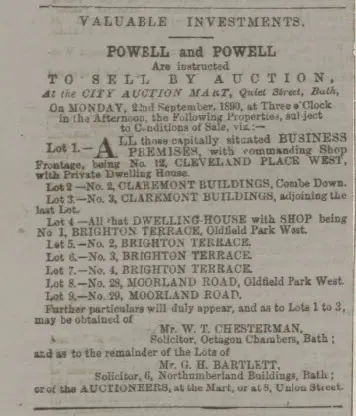
After Samuel Hope died the bank went to ruin, when ‘much imprudent business was done.’ This escalated in 1847 because of ‘excessive railway speculations’. The Bank of England had to intervene.
Ten years later ‘The Panic of 1857’ in America caused all major banks to panic, this had a knock on effect in England and on 27 October 1857 the Liverpool Borough Bank closed. The value of it’s bad debts and bad endorsements is the equivalent of about £1 £1.5 billion in 2016 terms.
"On 27th October 1857 the Borough Bank closed its doors. On examination of affairs it was found that its bad debts were exceedingly large. Some £600,000 to £700,000, previously taken as good, were now found to be almost valueless. They had £3,500,000 bills in London with the endorsement of the bank, and this amount some £700,000 to £1,000,000 “had no negotiable validity at all except that endorsement.” The whole total loss was estimated at £940,000 the whole capital of the bank being thus swept away."
When he died Samuel Hope must have left a large fortune to his children.
In 1896, Rev Fowler’s widow, Charlotte Maria sold 1 Claremont Buildings to Rhoda Mary Hope.
Rhoda Mary Hope had renamed 2 & 3 Claremont Buildings to Hope Cote and gave 1 Claremont Buildings which she had renamed Lyttlecote to her niece Augusta Morley (1843 – 1930).
Rhoda Mary Hope was an aunt of Mary Morley (1855 – 1917) who lived at St Christopher in Belmont.
Augusta Morley was the daughter of her elder sister Rebeka Maria Hope (1818 – 1888) who had married Samuel Morley (1809 – 1886) MP in 1841.
Augusta Morley had married Rev Marmaduke Washington (1846 – 1935).
Rev Washington was the son of a barrister and had been appointed Rector of Staple Fitzpaine in 1895[15].
He was still there in 1901[16] and remained Rector there until 1904.[17]
He became Hon. Canon of Norwich from 1916 – 1926.
When Rhoda Mary Hope died in 1910 she left £36,097 13s 5d (about £13,030,000.00 in 2016) and is buried at Bath Abbey cemetery.
1910 Dr Charles Middleton Coates
Dr Charles Middleton Coates (1857 – 1933) was the nephew of Rhoda Mary Hope and a cousin of Mary Morley (1855 – 1917) who lived at St Christopher in Belmont.
He was the son of her younger sister Sarah Clegg Hope (1832 – 1863) and her husband Dr Charles Coates (1825 – 1909) who lived at 10 The Circus.
He inherited Hopecote (previously 2 & 3 Claremont Buildings) and bought Lyttlecote (previously 1 Claremont Buildings) from Rev Marmaduke Washington and his wife Augusta. Rev Washington became Rector of Holbrook in Suffolk.
Dr Charles Middleton Coates made the three buildings into one that he called Hopecote. He had his surgery on the ground floor of Lyttlecote (previously 1 Claremont Buildings). He also radically changed Hopecote from 3 Georgian houses of 2 storeys into a single 3 storey building with mansard roof and windows.
As a matter of interest, Sarah Clegg Hope is the 2nd great-grandmother of Camilla Rosemary Shand (b. 1947) now Her Royal Highness The Duchess of Cornwall, Duchess of Rothesay, Countess of Chester, GCVO, CSM, PC the second wife of His Royal Highness Charles Philip Arthur George Windsor, Prince of Wales, Prince and Great Steward of Scotland, Duke of Cornwall, Duke of Rothesay, Earl of Chester, Earl of Carrick, Baron of Renfrew, Lord of The Isles, KG, KT, GCB, OM, AK, QSO, PC, ADC (b. 1948).
Her daughter Augusta Mary Coates (1859 – 1954) married Alexander Faulkner Shand (1858 – 1936) father of Philip Morton Shand (1888 – 1960) and grandfather of Major Bruce Middleton Hope Shand MC and bar (1917 – 2006).
Dr Charles Middleton Coates married Janet Rae (1864 – 1922) and they had 5 children.
His eldest son Dr. Vincent George Coates MC, MA, MD, MRCP (1890 – 1934) played rugby for England[18].
He was also an expert on arthritis at the Royal Mineral Water Hospital.
He died when he fell from the Paddington to Bath train[19].
Another son, Donald Bateman Hope Coates (1904 – 1994) seems to have been:
- a spy for the Cairo Gang (see also)
- in the Auxiliary Division of the Royal Irish Constabulary (ADRIC)
- in the Royal Flying Corps
- a pistolero.
1932 Helen Mary Coates and Joseph William Q Watterson
In 1932 Dr Charles Middleton Coates passed Hopecote to his daughter Helen Mary Coates (1899 – 1954) who had married Joseph William Q Watterson (1893 – 1954).
They were certainly living at Hopecote until 1937 but it seems that by 1938 they were renting it as:
"Mr Edward Oliver Pleydell-Bouverie of 'Hopecote', Combe Down, Bath and formerly of the Travellers Club, Pall Mall, London, who died on May 13th last, second son of the late Right-Hon Edward Pleydell-Bouverie..."[20]
So, Edward Oliver Pleydell-Bouverie (1856 – 1938), a son of Edward Pleydell-Bouverie PC FRS (1818 – 1889) was living there in 1937 – 38.
1942 Helen Mary Coates and Nora Collins
In 1942 Helen Mary Coates sold Hopecote to Miss Nora Collins and Hopecote became Hope Cote Hotel, though it seems to have been operating it as a hotel prior to this.[21]
1948 Nora Collins and Mr & Mrs Edward Smith
Miss Nora Collins sold the Hope Cote Hotel to Mr & Mrs Edward Smith.
1962 Converted to flats
In 1962 the Hope Cote Hotel was converted into flats and became Hope Cote Lodge.
Contents
- 1 1805
- 2 1815
- 3 1826 – 1831 James Davis, Robert Perks, Samuel Batchellor and William Batchellor
- 4 1840 1 – 3 Claremont Buildings for sale
- 5 1843 – 1846 Rev George William Newnham, Sophia Elizabeth Newnham and William Price
- 6 1863 William Fortt
- 7 1880 Rev Francis William Fowler
- 8 1890 Lucy Harding and Rhoda Mary Hope
- 9 1910 Dr Charles Middleton Coates
- 10 1932 Helen Mary Coates and Joseph William Q Watterson
- 11 1942 Helen Mary Coates and Nora Collins
- 12 1948 Nora Collins and Mr & Mrs Edward Smith
- 13 1962 Converted to flats



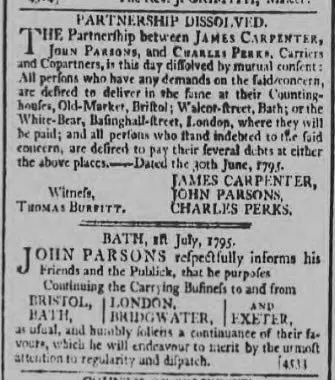
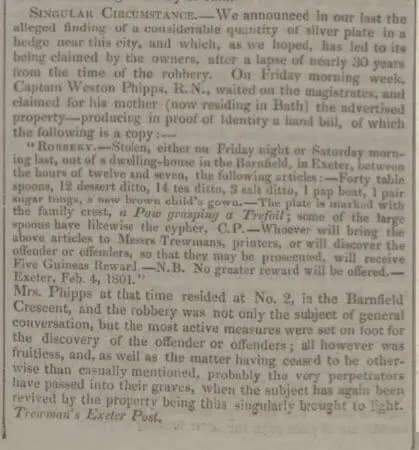
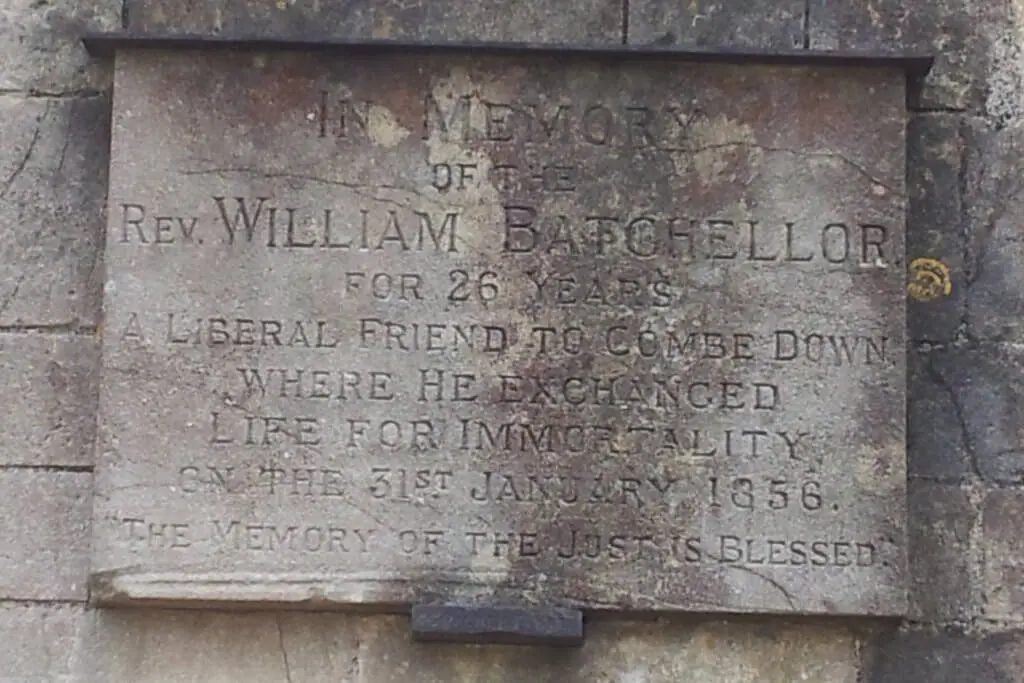
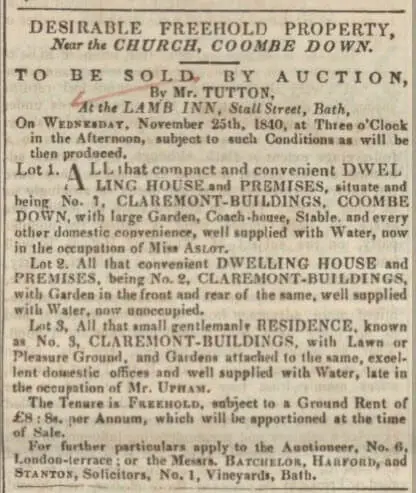
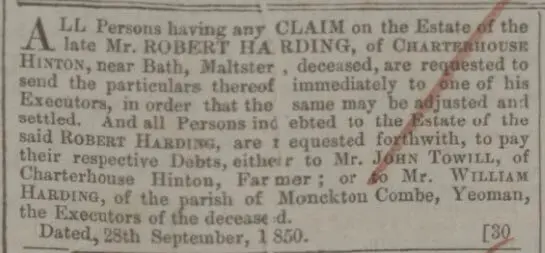


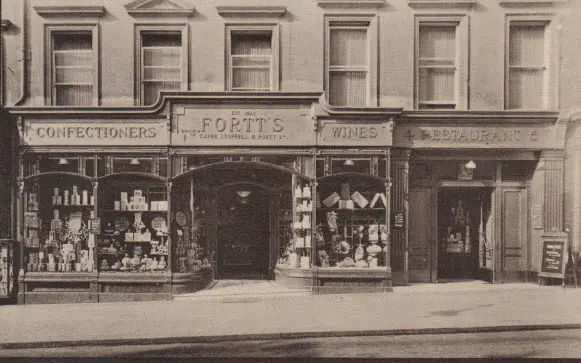
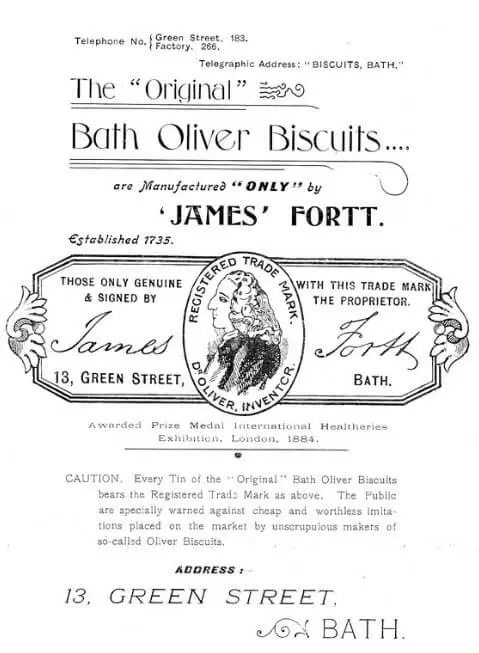
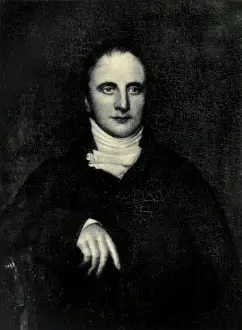

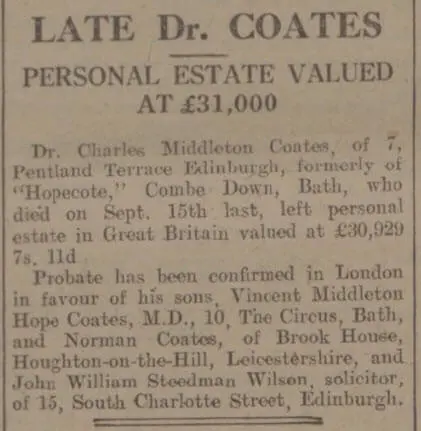
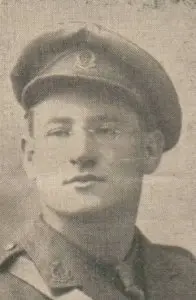
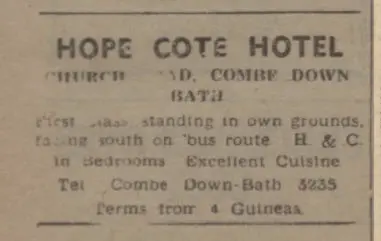
Comments are closed.